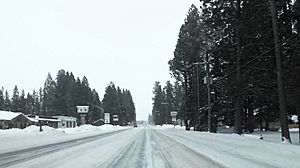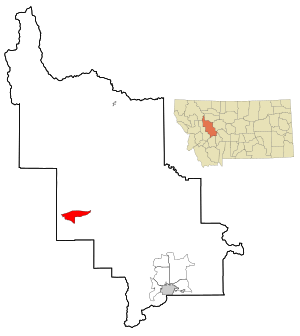Lincoln, Montana facts for kids
Quick facts for kids
Lincoln, Montana
|
|
|---|---|

Downtown Lincoln in the winter
|
|
 |
|
| Country | |
| State | |
| County | Lewis and Clark |
| Area | |
| • Total | 18.06 sq mi (46.79 km2) |
| • Land | 17.55 sq mi (45.44 km2) |
| • Water | 0.52 sq mi (1.34 km2) |
| Elevation | 4,541 ft (1,384 m) |
| Population
(2020)
|
|
| • Total | 998 |
| • Density | 56.88/sq mi (21.96/km2) |
| Time zone | UTC−7 (Mountain (MST)) |
| • Summer (DST) | UTC−6 (MDT) |
| ZIP Code |
59639
|
| Area code(s) | 406 |
| FIPS code | 30-43675 |
| GNIS feature ID | 0801064 |
Lincoln is a small town in Lewis and Clark County, Montana, United States. It's not officially a city, but it's a recognized community. In 2020, about 998 people lived there.
Contents
Discovering Lincoln's Past
Lincoln has a rich history, starting with early explorers and gold miners.
Early Explorers and Gold Rush Days
In 1806, Meriwether Lewis traveled through this area. He was on his way back to St. Louis after his famous expedition. He followed an old trail used by Native Americans for hundreds of years.
In the mid-1860s, people found gold nearby. This brought many miners to the area. Lincoln was created when miners left another spot called Lincoln Gulch. They moved to the town's current location.
Lincoln as a Commercial Hub
In the early 1900s, Lincoln became an important center. People came for fun activities, logging, and mining along the Blackfoot River. Today, the beautiful wilderness nearby still attracts visitors and people who want to live there.
Historic Buildings in Lincoln
Two important buildings in Lincoln are listed on the National Register of Historical Places. These are the Lincoln Community Hall, built in 1918, and the Hotel Lincoln, built in 1914. They are part of the town's history.
The 2017 Earthquake in Lincoln
On July 6, 2017, at 12:30 a.m., a strong earthquake happened near Lincoln. It was a 5.8-magnitude earthquake, about 6 miles south of town. The earthquake started almost 3 miles underground. It was near a fault system called the Lewis and Clark line. This line stretches 250 miles from northern Idaho to east of Helena, Montana.
This earthquake was the eighth strongest ever recorded in Montana. After the main quake, there were at least nine smaller tremors. These happened within the first hour and ranged from 3.1 to 4.9 in magnitude.
Lincoln's Location and Weather
Lincoln is found in western Lewis and Clark County. It sits at an elevation of 4,541 feet above sea level.
Where is Lincoln Located?
The community of Lincoln stretches about 6 miles east along the Blackfoot River valley. It also goes about 3 miles west. The total area of Lincoln is about 18.06 square miles. Most of this is land, with a small part being water.
Lincoln is on Montana Highway 200. This is the longest state highway in the United States, running 706.6 miles. It goes all the way from Idaho to North Dakota. From Lincoln, the highway goes northeast over the Continental Divide to Great Falls, which is 87 miles away. It also goes west 77 miles to Missoula.
What is Lincoln's Climate Like?
Lincoln has a climate that is mostly humid continental climate. This means it has warm to hot summers. Winters are cold and snowy. On average, Lincoln gets about 85.4 inches of snow each year.
Rogers Pass, which is 18 miles northeast of Lincoln, is famous for something special. On January 20, 1954, it recorded the coldest temperature in the United States outside of Alaska: −70 degrees Fahrenheit. The snow in Lincoln is usually light and powdery. However, sometimes storms from the Pacific Ocean bring heavier, wetter snow.
| Climate data for Lincoln, Montana, 1991–2020 normals, extremes 1948–2012 | |||||||||||||
|---|---|---|---|---|---|---|---|---|---|---|---|---|---|
| Month | Jan | Feb | Mar | Apr | May | Jun | Jul | Aug | Sep | Oct | Nov | Dec | Year |
| Record high °F (°C) | 59 (15) |
60 (16) |
72 (22) |
84 (29) |
92 (33) |
94 (34) |
102 (39) |
102 (39) |
98 (37) |
84 (29) |
68 (20) |
55 (13) |
102 (39) |
| Mean maximum °F (°C) | 47.1 (8.4) |
50.3 (10.2) |
60.1 (15.6) |
72.6 (22.6) |
81.0 (27.2) |
87.1 (30.6) |
93.3 (34.1) |
92.5 (33.6) |
86.1 (30.1) |
73.7 (23.2) |
56.6 (13.7) |
44.9 (7.2) |
94.9 (34.9) |
| Mean daily maximum °F (°C) | 31.7 (−0.2) |
34.7 (1.5) |
43.9 (6.6) |
52.6 (11.4) |
62.5 (16.9) |
71.1 (21.7) |
81.3 (27.4) |
81.1 (27.3) |
70.2 (21.2) |
54.4 (12.4) |
38.9 (3.8) |
30.5 (−0.8) |
54.4 (12.4) |
| Daily mean °F (°C) | 22.0 (−5.6) |
25.1 (−3.8) |
32.8 (0.4) |
39.7 (4.3) |
47.9 (8.8) |
55.6 (13.1) |
62.6 (17.0) |
61.4 (16.3) |
52.8 (11.6) |
41.5 (5.3) |
29.5 (−1.4) |
21.6 (−5.8) |
41.0 (5.0) |
| Mean daily minimum °F (°C) | 12.3 (−10.9) |
15.4 (−9.2) |
21.7 (−5.7) |
26.8 (−2.9) |
33.2 (0.7) |
40.1 (4.5) |
43.8 (6.6) |
41.6 (5.3) |
35.4 (1.9) |
28.5 (−1.9) |
20.0 (−6.7) |
12.8 (−10.7) |
27.6 (−2.4) |
| Mean minimum °F (°C) | −17.4 (−27.4) |
−14.6 (−25.9) |
−1.7 (−18.7) |
13.6 (−10.2) |
21.6 (−5.8) |
28.9 (−1.7) |
33.4 (0.8) |
29.7 (−1.3) |
21.2 (−6.0) |
9.1 (−12.7) |
−3.5 (−19.7) |
−16.0 (−26.7) |
−28.3 (−33.5) |
| Record low °F (°C) | −48 (−44) |
−44 (−42) |
−34 (−37) |
−8 (−22) |
8 (−13) |
19 (−7) |
24 (−4) |
21 (−6) |
6 (−14) |
−13 (−25) |
−45 (−43) |
−48 (−44) |
−48 (−44) |
| Average precipitation inches (mm) | 1.49 (38) |
2.30 (58) |
1.25 (32) |
1.46 (37) |
1.99 (51) |
2.62 (67) |
0.82 (21) |
1.04 (26) |
1.33 (34) |
1.63 (41) |
1.35 (34) |
1.49 (38) |
18.77 (477) |
| Average snowfall inches (cm) | 15.1 (38) |
10.0 (25) |
7.4 (19) |
3.2 (8.1) |
1.1 (2.8) |
1.2 (3.0) |
0.0 (0.0) |
0.0 (0.0) |
0.5 (1.3) |
2.1 (5.3) |
9.5 (24) |
16.5 (42) |
66.6 (168.5) |
| Average extreme snow depth inches (cm) | 12.4 (31) |
12.1 (31) |
10.1 (26) |
4.3 (11) |
0.9 (2.3) |
0.4 (1.0) |
0.0 (0.0) |
0.0 (0.0) |
0.2 (0.51) |
1.2 (3.0) |
4.5 (11) |
9.6 (24) |
17.0 (43) |
| Average precipitation days (≥ 0.01 in) | 9.0 | 8.3 | 9.3 | 8.8 | 11.0 | 12.3 | 7.4 | 6.6 | 6.9 | 8.5 | 8.6 | 8.1 | 104.8 |
| Average snowy days (≥ 0.1 in) | 6.1 | 5.0 | 4.4 | 1.5 | 0.4 | 0.2 | 0.0 | 0.0 | 0.1 | 1.0 | 4.7 | 6.7 | 30.1 |
| Source 1: NOAA | |||||||||||||
| Source 2: National Weather Service (mean maxima/minima, snow/snow days/snow depth 1981–2010) | |||||||||||||
Who Lives in Lincoln?
Here's a look at the people who call Lincoln home.
| Historical population | |||
|---|---|---|---|
| Census | Pop. | %± | |
| 2000 | 1,100 | — | |
| 2010 | 1,013 | −7.9% | |
| 2020 | 998 | −1.5% | |
| U.S. Decennial Census | |||
Population and Households
In 2010, Lincoln had 1,013 people living there. There were 507 households, which are groups of people living together. About 296 of these were families. The population density was about 56.6 people per square mile. There were 846 housing units in total.
Most people in Lincoln are White, making up 95.5% of the population. About 2.2% are Native American, and 0.2% are Asian. Another 1.9% are from two or more races. About 1.5% of the population is Hispanic or Latino.
Family Life and Age Groups
Out of all the households, 16.6% had children under 18 living with them. Almost half, 48.3%, were married couples. About 6.7% had a female head of household with no husband present. The average household had 2 people, and the average family had 2.55 people.
The population in Lincoln is spread out by age. About 16.3% are under 18 years old. A large group, 41.2%, are between 45 and 64 years old. About 22.8% are 65 years or older. The average age in Lincoln was 53 years old. For every 100 females, there were about 108 males.
Lincoln's Facilities and Schools
Lincoln has its own airport and a school district.
Transportation in Lincoln
Lincoln Airport is a public airport. It is located 2 miles east of the town.
Education in Lincoln
Public schools in Lincoln are managed by Lincoln Public School District #38. This district teaches students from kindergarten all the way through 12th grade. The sports teams at Lincoln High School are called the Lynx.
Lincoln also has a public library. It is a branch of the Lewis & Clark Library system.
Lincoln in Pop Culture
Lincoln and its surroundings have appeared in movies.
Movies Set Near Lincoln
Bugle Mountain, also known as "Bugle Peak," is near Lincoln. It's located in the Scapegoat Wilderness. This mountain was the setting for a forest fire in the 1952 movie Red Skies of Montana. The movie was partly based on a real fire, the tragic 1949 Mann Gulch fire, and was filmed in Montana.
News and Media in Lincoln
Lincoln has its own online newspaper.
Local News Sources
The Blackfoot Valley Dispatch is an online newspaper that covers news in Lincoln. The town also receives radio stations from the larger Helena area.
Notable People from Lincoln
Some well-known people have lived in Lincoln.
- Doug Swingley: He is famous for winning the Iditarod Trail Sled Dog Race four times.
Images for kids
See also
 In Spanish: Lincoln (Montana) para niños
In Spanish: Lincoln (Montana) para niños




